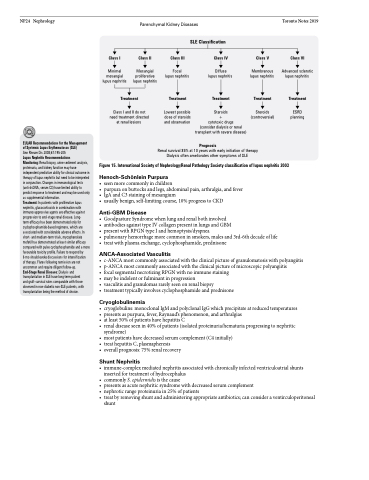Page 724 - TNFlipTest
P. 724
NP24 Nephrology
Parenchymal Kidney Diseases
Toronto Notes 2019
SLE Classification
Class I
Minimal mesangial lupus nephritis
Class II
Mesangial proliferative lupus nephritis
Class III
Focal lupus nephritis
Treatment
Lowest possible dose of steroids and observation
Class IV
Diffuse lupus nephritis
Treatment
Steroids
+
cytotoxic drugs (consider dialysis or renal transplant with severe disease)
Prognosis
Class V
Membranous lupus nephritis
Treatment
Steroids (controversial)
Class VI
Advanced sclerotic lupus nephritis
Treatment
ESRD planning
Treatment
Class I and II do not need treatment directed at renal lesions
EULAR Recommendations for the Management of Systemic Lupus Erythematosus (SLE)
Ann Rheum Dis 2008;67:195-205
Lupus Nephritis Recommendations
Monitoring: Renal biopsy, urine sediment analysis, proteinuria, and kidney function may have independent predictive ability for clinical outcome in therapy of lupus nephritis but need to be interpreted in conjunction. Changes in immunological tests (anti-dsDNA, serum C3) have limited ability to predict response to treatment and may be used only as supplemental information.
Treatment: In patients with proliferative lupus nephritis, glucocorticoids in combination with immunosuppressive agents are effective against progression to end-stage renal disease. Long-
term efficacy has been demonstrated only for cyclophosphamide-based regimens, which are associated with considerable adverse effects. In short- and medium-term trials, mycophenolate mofetil has demonstrated at least similar efficacy compared with pulse cyclophosphamide and a more favourable toxicity profile. Failure to respond by
Renal survival 85% at 10 years with early initiation of therapy Dialysis often ameliorates other symptoms of SLE
6 mo should evoke discussions for intensification of therapy. Flares following remission are not uncommon and require diligent follow-up. End-Stage Renal Disease: Dialysis and transplantation in SLE have long-term patient and graft-survival rates comparable with those observed in non-diabetic non-SLE patients, with transplantation being the method of choice.
Figure 15. International Society of Nephrology/Renal Pathology Society classification of lupus nephritis 2003
Henoch-Schönlein Purpura
• seenmorecommonlyinchildren
• purpuraonbuttocksandlegs,abdominalpain,arthralgia,andfever • IgAandC3stainingofmesangium
• usuallybenign,self-limitingcourse,10%progresstoCKD
Anti-GBM Disease
• GoodpastureSyndromewhenlungandrenalbothinvolved
• antibodiesagainsttypeIVcollagenpresentinlungsandGBM
• presentwithRPGNtypeIandhemoptysis/dyspnea
• pulmonaryhemorrhagemorecommoninsmokers,malesand3rd-6thdecadeoflife • treatwithplasmaexchange,cyclophosphamide,prednisone
ANCA-Associated Vasculitis
• c-ANCAmostcommonlyassociatedwiththeclinicalpictureofgranulomatosiswithpolyangiitis • p-ANCAmostcommonlyassociatedwiththeclinicalpictureofmicroscopicpolyangiitis
• focalsegmentalnecrotizingRPGNwithnoimmunestaining
• maybeindolentorfulminantinprogression
• vasculitisandgranulomasrarelyseenonrenalbiopsy
• treatmenttypicallyinvolvescyclophosphamideandprednisone
Cryoglobulinemia
• cryoglobulins:monoclonalIgMandpolyclonalIgGwhichprecipitateatreducedtemperatures • presentsaspurpura,fever,Raynaud’sphenomenon,andarthralgias
• atleast50%ofpatientshavehepatitisC
• renaldiseaseseenin40%ofpatients(isolatedproteinuria/hematuriaprogressingtonephritic
syndrome)
• mostpatientshavedecreasedserumcomplement(C4initially) • treathepatitisC,plasmapheresis
• overallprognosis:75%renalrecovery
Shunt Nephritis
• immune-complexmediatednephritisassociatedwithchronicallyinfectedventriculoatrialshunts inserted for treatment of hydrocephalus
• commonlyS.epidermidisisthecause
• presentsasacutenephriticsyndromewithdecreasedserumcomplement
• nephroticrangeproteinuriain25%ofpatients
• treatbyremovingshuntandadministeringappropriateantibiotics;canconsideraventirculoperitoneal
shunt


